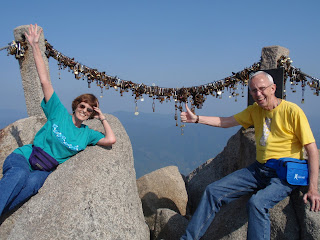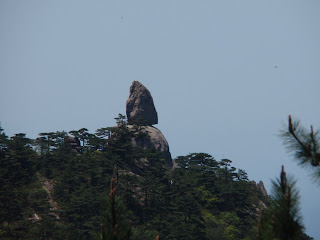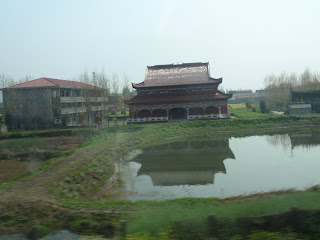
Last week we took a trip to HuangShan or, in English, Yellow Mountain. We went with the Johnson's and Stephen, the student I have been tutoring this year. We knew we needed help to manage the trip, language, lodging, and just to keep us from getting lost on the mountain so we took Stephen with us. He did a wonderful job and we had a great time with him. Here we are at the entrance to Yellow Mountain.
HuangShan is a large national park noted for its huge granite outcroppings. The park is one of the top 10 sights in China. Artists and poets have long drawn inspiration from the area. I think it used to be a quiet place where they could work and contemplate in peace. Not so, today. Crowds of tourists are everywhere--but this is China and people are expected.
There are three main ways up into the mountains--hike up the difficult east steps, hike up the more difficult west steps, or go the easy way by taking a cable car. We chose the third option because we wanted to save some strength for hiking up at the top.
Here we are with our backpacks, ready to hike. As you can see the trail is steps, but well maintained steps. Lest you get the impression that we were actually backpacking--as in camping--let me dispel that notion. We backpacked from one hotel to another. There are no camping facilities on the mountain. People either stay in the valley or in one of 3 or 4 hotels scattered throughout the hiking area on top. That is my kind of backpacking!!!
Here we are at the "welcoming pine." It is located near the hotel where we spent the first night. We had checked in and were on our way to the top of the mountain you can see behind us. It is called Celestial Peak or Heavenly Capital Peak--depending on which map you use.
A close-up of the top of Celestial Peak.
Before we could start our ascent, we had to go down to the foot of the valley between where we were and the base of the peak.
Starting the climb. There was very little "trail," just steps, and more steps, and more steps--1321, not counting the 580 steps we had come down and would have to climb back up. Jim loved it since he will run the Great Wall Marathon this Sat. and it has 4,000 steps. This was great practice for him and he is now confident that he can do the marathon. Anyway, up we went.
And up some more. This looks a little scarier than it really was. Most of the steps were carved right out of the granite, as were hand rails in many places. The ropes were very helpful and we were grateful for them.
We finally got to a flat place instead of steps. This is called "fishback ridge." You can see why--the drop off on both sides was daunting. I took a deep breath, told myself I could do it and went across. Jim took videos of my efforts.
But eventually we made it to the top. The view was spectacular--a 360 degree vista that was, literally, breathtaking. Here we are at the top. You can't see much of the valley--too smoggy--but here we were above the air pollution and the sky was a beautiful blue. The locks on the chains are the typical "love locks" with no key and the names of the couple engraved on the lock. It is there forever and a symbol of their eternal devotion to each other.

The next day we got up and watched the sunrise. Then we hiked from one hotel to another. This was not as strenuous (thank goodness) but still a climb up and down hundreds, if not thousands, of steps. It took us about 4 hours. The trail was crowded with people but once in a while we found ourselves in a quiet area. It was fun to see what we would run across as we hiked. Here is a typical Chinese bridge. Walking up over it was supposed to bring long life.
This area is called "Stairway to Heaven." You can see many people on it. We actually bypassed this steep cllimb because Walt Johnson has bad knees. We took a less steep, but longer, route. Either way we still had to climb to the top.

Some people chose not to climb themselves. As we watched them in the sedan chairs, I was glad to be walking. The chairs were bouncy and the men carrying them moved very fast. They must have tremendous leg muscles!

There are no roads to the top of the mountain so everything has to be carried in. All the supplies come up the cable cars and then are hauled to the various hotels, eating places, etc. Here are vegetables and boxes of water for dinner. We saw people carrying linens as well as food, pumps, metal, and then trash on its way down.

The most unique sight, however, was the men carrying this bathtub full of paint cans and other construction things. Yes, this is a bathtub!!! I guess all the construction materials and furnishings for the various hotels and restaurants were actually hauled up the mountain in this way!!!

Chinese have a great talent for descriptive names. The small rock balanced in the background is called, "flying over rock." That's because it looks like it was flying over and just dropped down and landed.

Some of the breathtaking scenery. The pictures don't do justice to the beauty of the area. The air pollution gets in the way and the immenseness of the place is lost in just a small picture.

Everywhere we looked, it was spectacularly beautiful.

But at last we came to the end of our three days at HuangShan. It is one of the most memorable times we have had here in China and we were so grateful that we were able to have warm, sunny weather for our trip. Many of the pictures you see of this area show the peaks above the "cloud sea" but we were happy to complete our journey in the sunshine.





























.JPG)

















